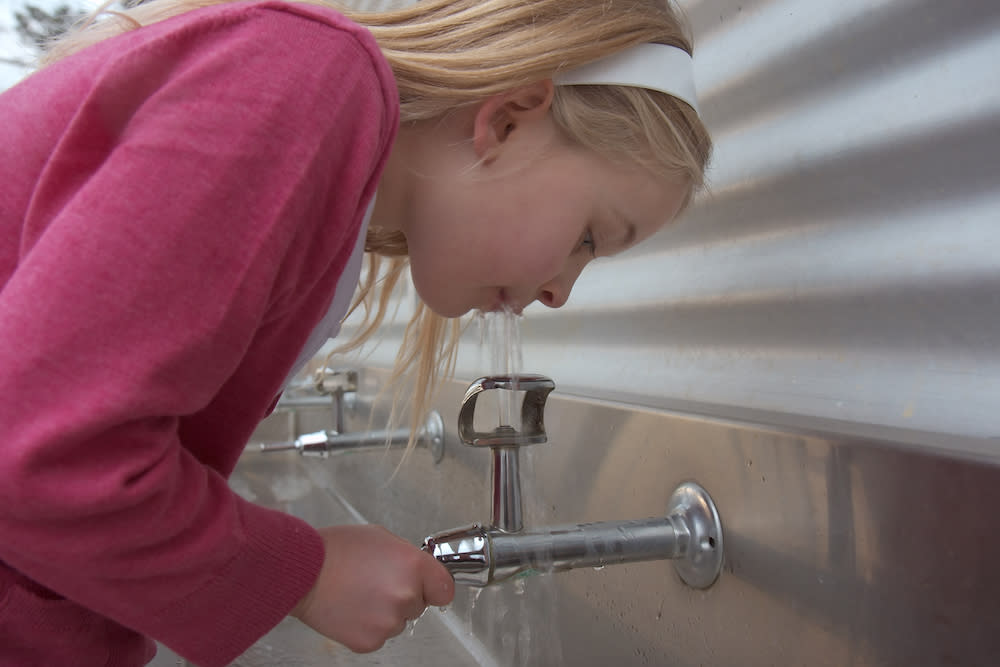Dangerous Levels of Lead Found in Water at Schools Across the Country

March 22, 2019
Unsafe levels of lead are lurking in the drinking water of schools across the country, according to an alarming report released Thursday.
The report, Get the Lead Out, published by the Environment America Research & Policy Center and U.S. Public Research Interest Group Education Fund, reveals water from thousands of faucets and fountains at schools and preschools in America contained more than 1 part per billion (ppb) of lead. The American Academy of Pediatrics recommends water lead concentrations don't exceed 1 ppb.
Most schools tested had five times that amount. Others had even more, including Leicester Memorial Elementary in Massachusetts which had a tap that tested at 22,400 ppb.
Even low levels of lead exposure can affect children's brain development and possibly lower their IQ, says Morri Markowitz, M.D., a pediatrician and director of the Lead Poisoning Prevention Program at the Children's Hospital at Montefiore in the Bronx, New York, who consulted on the report. It has also been linked to learning and behavioral problems. The metal is especially toxic to young children, who absorb up to five times more of the lead they ingest than adults do.
It's not news that lead is bad for us—that's why the toxin has been removed from gasoline and paint over the years. And the federal Lead and Copper Rule was passed in 1991, which limits the amount of lead in public drinking water. So why is the toxic metal still so prevalent in schools?
A Look at a Widespread Problem
According to the new report, school drinking water is picking up the metal from service lines, pipes and plumbing, and lead-lined fountains and faucets. These systems should be regulated by state and local laws—but those are falling short.
"Unfortunately, even with the increase we've seen in school's testing their water for lead over the past few years, our results show a major, extensive problem," says John Rumpler, co-author of the report and senior director of Clean Water for America. "From Washington to Montana to Massachusetts, policymakers aren't doing enough to make sure our kids have safe drinking water every day."
The report graded 31 states and the District of Columbia on their efforts to protect children from lead in school water. It evaluated factors like how and when they require water testing and how much information they share with parents and the public. Twenty-two of the states received a failing grade. "Some of these states have no laws that address lead contamination, while others use unreliable tests to monitor the issue," Rumpler explains.
RELATED: Is Baby Powder Safe
No states received an A grade, but the District of Columbia topped the list with a B+. It's the only area of the country that requires schools and child care centers to install filters at every tap used for drinking or cooking. It also tests school water every year and publishes the testing data online.
Illinois got the second-highest mark with a B-. The state's Department of Health requires schools to take action if they detect any level of lead in their drinking water. However, Rumpler says, the state could improve by offering schools clear guidelines on exactly how to fix the problem.
A few other states, including Massachusetts, Vermont, Washington, Pennsylvania, and Montana, have taken action by proposing laws that, if and when adopted, could help boost their grades.
Rumpler says the remaining 19 states were not included in the report because initial research showed they didn't have any related laws or regulations to evaluate.
What Parents Can Do
The report includes a host of recommendations for federal lawmakers, such as strengthening rules around drinking water and providing funding to help states remove lead-laden plumbing, but that kind of change will take some time. In the meantime, there are several things parents can do to reduce their children's exposure to the toxin in schools.
"Parents shouldn't approach this with hysteria, thinking that their children are damaged," Dr. Markowitz says. "But we know there are no healthy levels of lead, so it's a good idea to take steps to reduce their exposure as much as possible."
Rumpler says parents should contact their child's school to find out if the water has been tested for lead, and ask to view the test results. (Some schools are only required to report lead levels above 15 ppb.)
"An initial, cost-effective step is to ask your school to put filters on every faucet and drinking fountain," Rumpler says. "Don't forget the cooking water faucets, too. Experts say if there's lead in the water you use to boil pasta for mac and cheese, there's going to be lead in that mac and cheese."
A next step would be to ask the school to replace any lead-lined drinking fountains with water bottle filling stations that have built-in filters. And you could also send your child to school with bottled water, Rumpler says, but keep in mind that the standard for lead levels in bottled water is 5 ppb. "It may be an improvement, but it's not the best long-term solution," he says. Or consider splurging on a water bottle with a built-in filter that gets rid of lead, like the
from Aquaovo.
Concerned parents can also take it a step further and contact their state's governor to urge him or her to take action against lead in drinking water.
"As parents, we care deeply about our kids' future," Rumpler says, "and we'd hate to think their health was compromised by something we take for granted, like safe drinking water."

